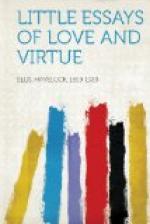CHAPTER III
THE OBJECTS OF MARRIAGE
What are the legitimate objects of marriage? We know that many people seek to marry for ends that can scarcely be called legitimate, that men may marry to obtain a cheap domestic drudge or nurse, and that women may marry to be kept when they are tired of keeping themselves. These objects in marriage may or may not be moral, but in any case they are scarcely its legitimate ends. We are here concerned to ascertain those ends of marriage which are legitimate when we take the highest ground as moral and civilised men and women living in an advanced state of society and seeking, if we can, to advance that state of society still further.
The primary end of marriage is to beget and bear offspring, and to rear them until they are able to take care of themselves. On that basis Man is at one with all the mammals and most of the birds. If, indeed, we disregard the originally less essential part of this end—that is to say, the care and tending of the young—this end of marriage is not only the primary but usually the sole end of sexual intercourse in the whole mammal world. As a natural instinct, its achievement involves gratification and well-being, but this bait of gratification is merely a device of Nature’s and not in itself an end having any useful function at the periods when conception is not possible. This is clearly indicated by the fact that among animals the female only experiences sexual desire at the season of impregnation, and that desire ceases as soon as impregnation takes place, though this is only in a few species true of the male, obviously because, if his sexual desire and aptitude were confined to so brief a period, the chances of the female meeting the right male at the right moment would be too seriously diminished; so that the attentive and inquisitive attitude towards the female by the male animal—which we may often think we see still traceable in the human species—is not the outcome of lustfulness for personal gratification ("wantonly to satisfy carnal lusts and appetites like brute beasts,” as the Anglican Prayer Book incorrectly puts it) but implanted by Nature for the benefit of the female and the attainment of the primary object of procreation. This primary object we may term the animal end of marriage.




